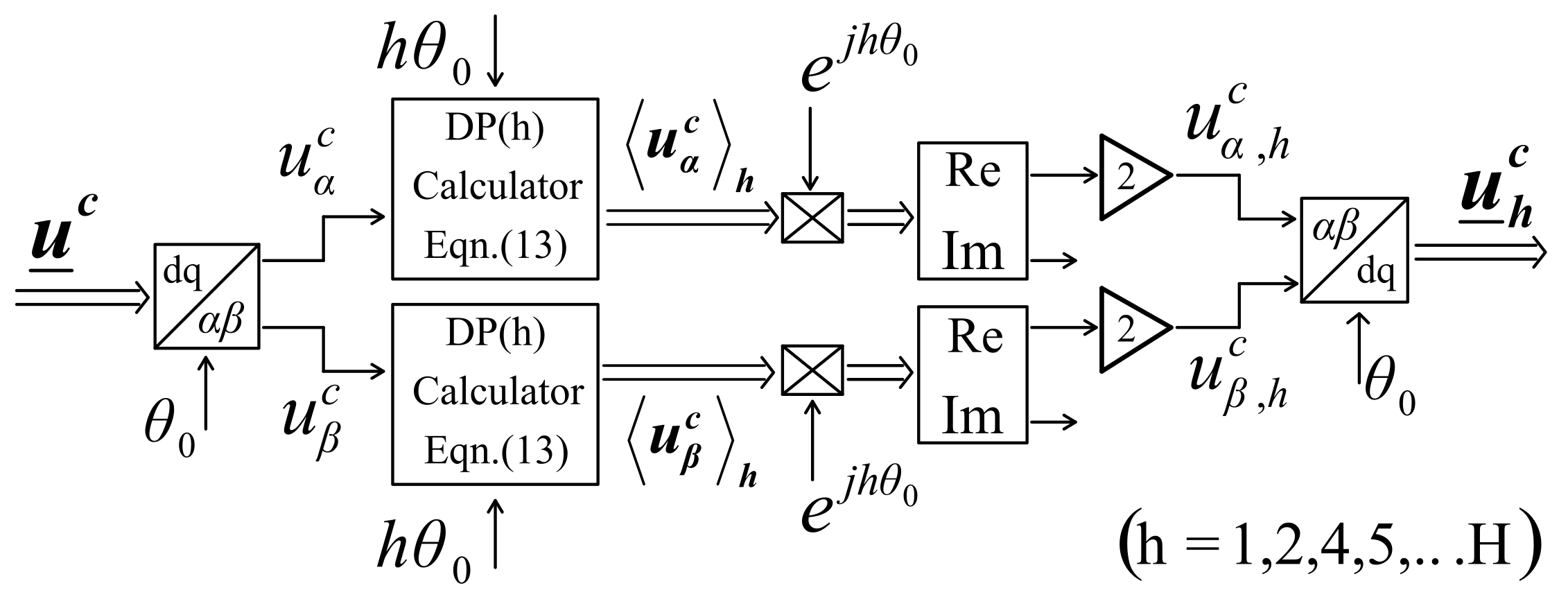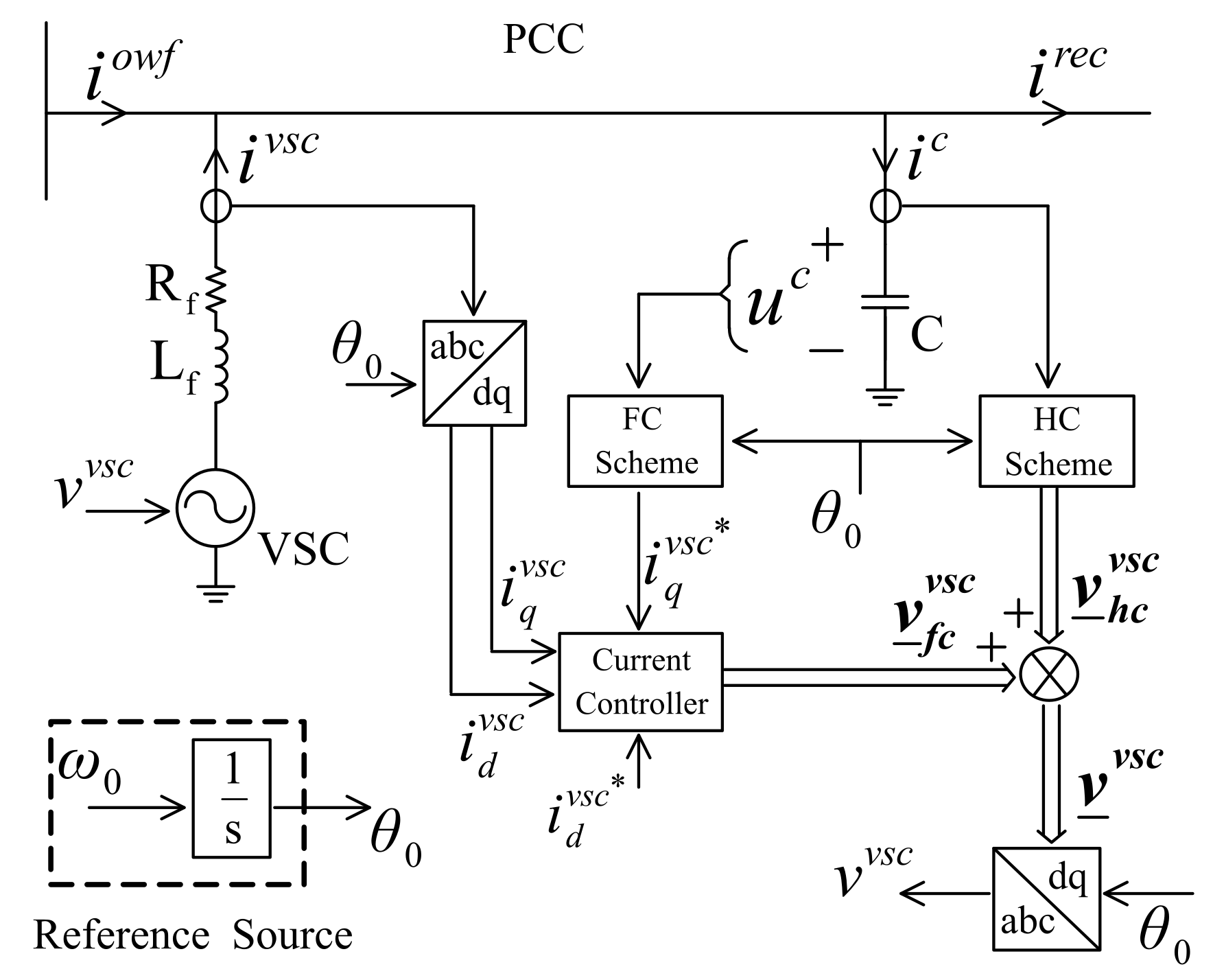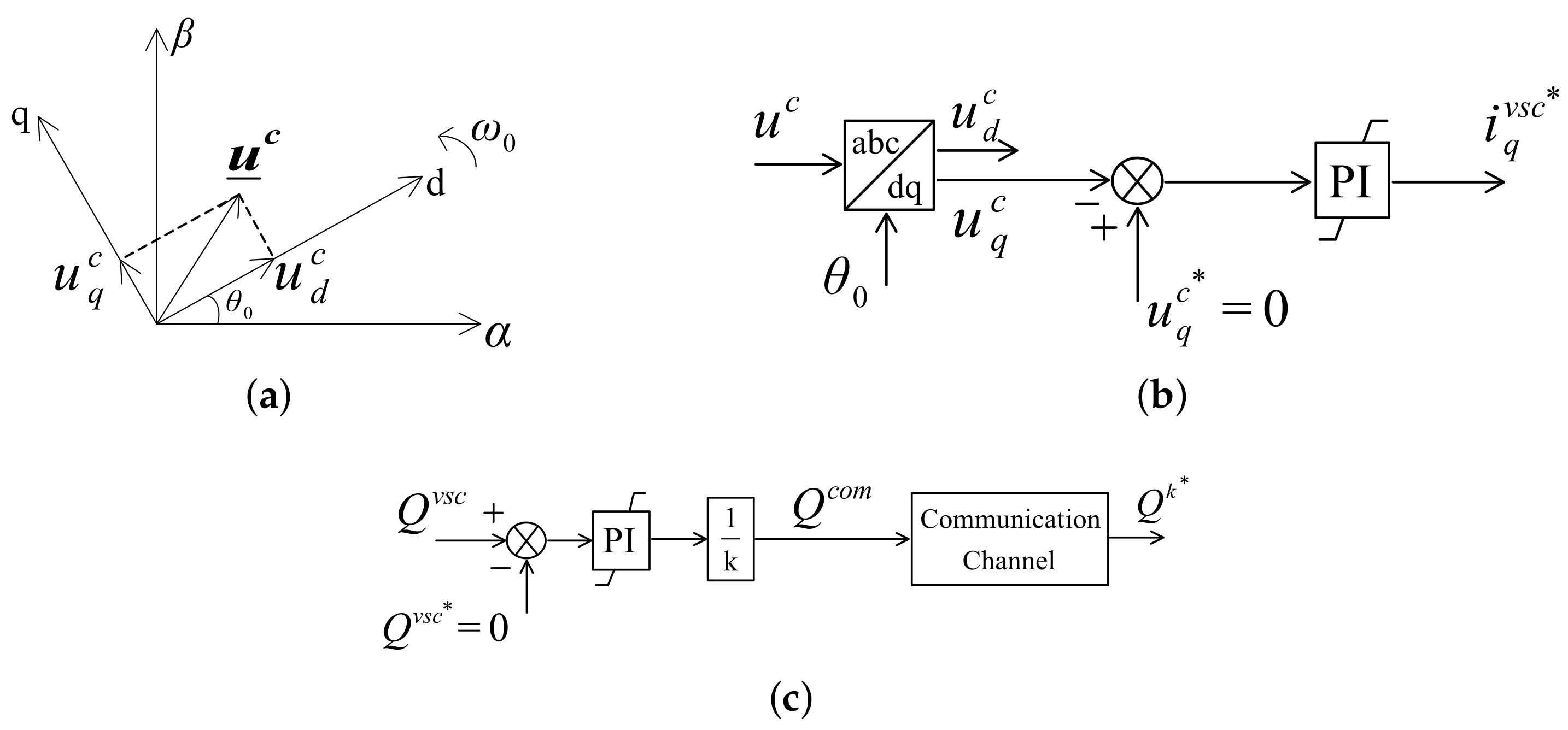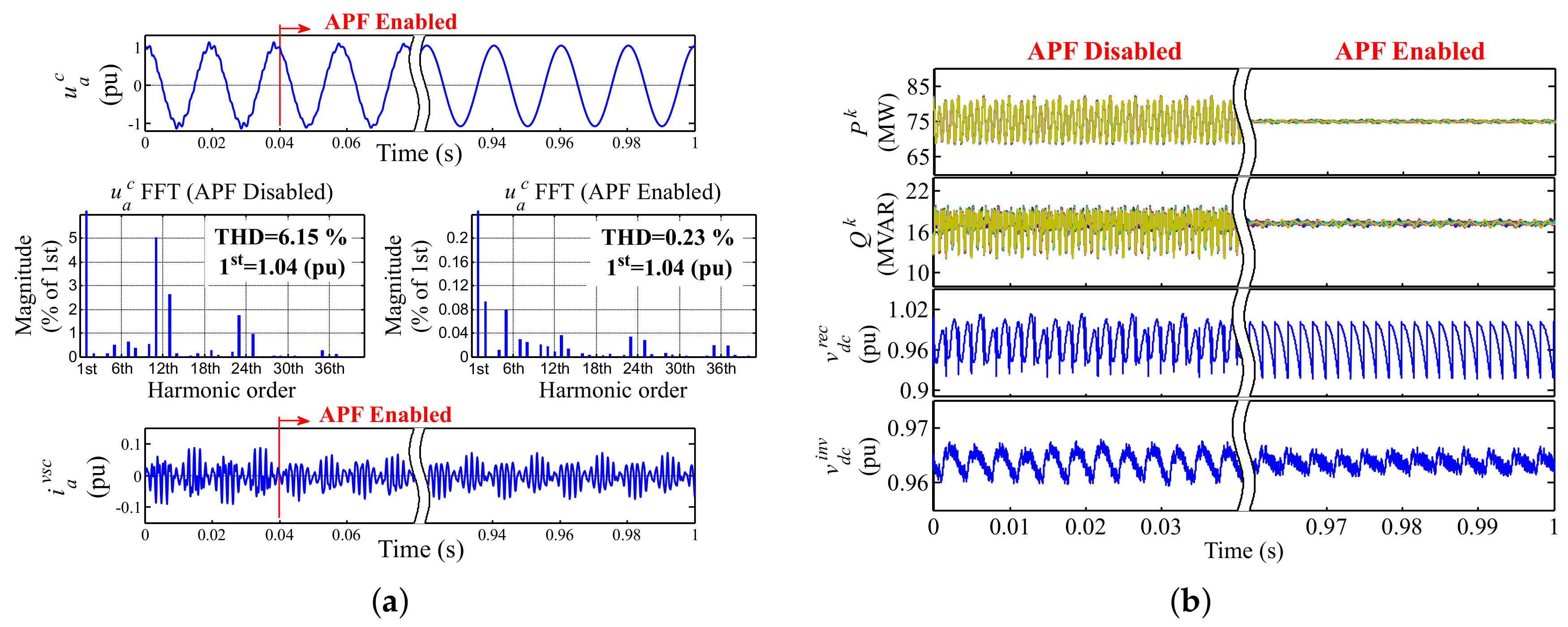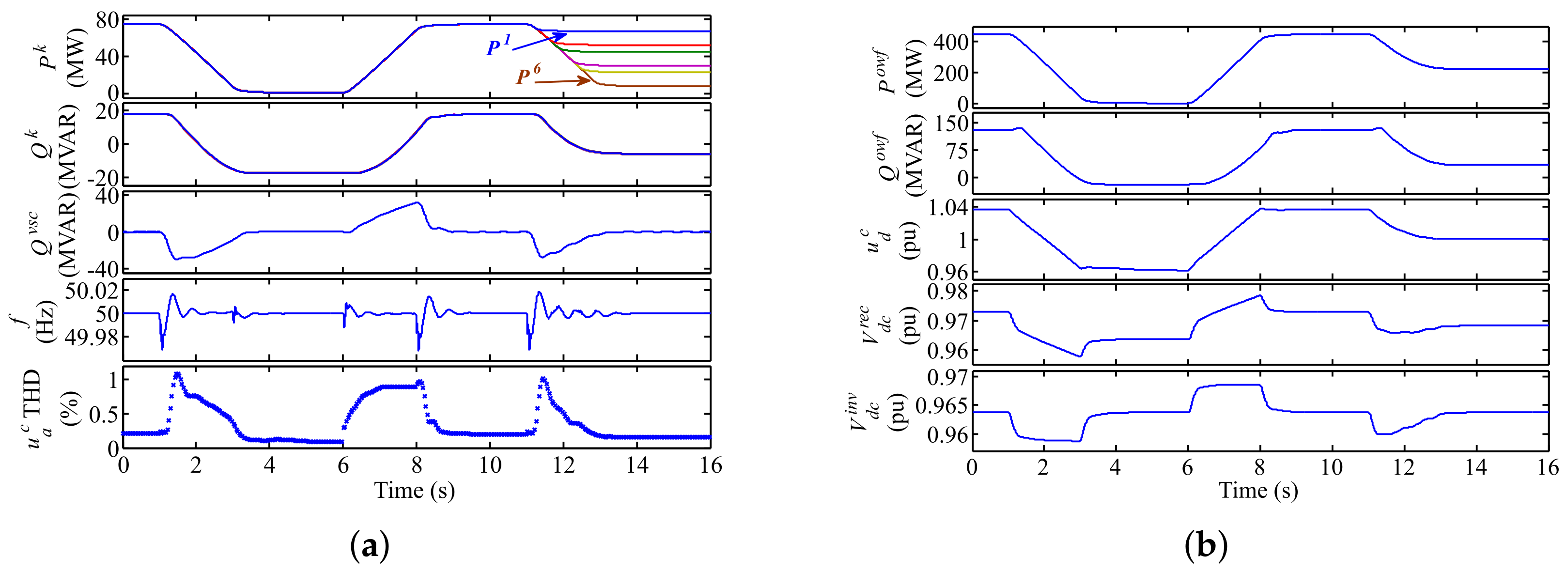1. Introduction
Recently, offshore wind farms (OWFs) have been developed due to the better offshore wind conditions. Since OWFs are planned to be located at long distances from the shore, a high voltage direct current (HVDC) transmission system is the preferable technology compared to high voltage alternating current (HVAC), for the integration of OWFs to the onshore grid [
1]. Two main HVDC technologies are line-commutated converters (LCCs) that use thyristors and forced-commutated voltage source converters (VSCs) that use, in most industrial cases, insulated gate bipolar transistors (IGBTs).
The VSC-based HVDC transmission system offers more controllability, such as voltage and frequency control, for the isolated offshore ac-grid. Despite operational advantages, VSC-based HVDC has higher overall losses, is more vulnerable to line faults, and needs higher maintenance compared to LCCs [
1,
2]. In addition, it requires the construction of an offshore platform, further increasing the cost. Recently, various studies on OWF configurations based on series and parallel dc collection and transmission have been investigated to minimize losses and installation costs by eliminating the need for VSC offshore platforms [
3,
4,
5]. However, such configurations require a number of conversion stages for power conversion via multiple stages of transformers and ac–dc and dc–dc stages which need to be located in one or more offshore platforms, further increasing the costs and losses. In order to overcome the aforementioned drawbacks, a new HVDC technology that integrates OWFs was proposed in [
6] in which diode-rectifier-based HVDC links are employed. The new approach uses diode rectifier stations in HVDC links for OWF applications, resulting in a better performance in terms of efficiency, cost, converter size, and reliability [
7].
A disadvantage of the diode rectifier solution is the lack of control for frequency in the offshore ac-grid, given that the isolated OWF grid cannot generate the required frequency for the diode rectifier commutation. Moreover, due to the missing ac-voltage source at the rectifier station defining the frequency, the conventional wind turbine (WT) converter grid synchronisation via a phase-locked loop (PLL) is unfeasible for this system. The frequency control solutions for OWFs connected to diode-rectifier-based HVDC links proposed in the literature can be classified generally into two different solutions: distributed and centralised. In distributed control solutions, the frequency control is implemented in the WTs [
8,
9,
10], where type-4 WTs are considered because of their higher control flexibility. However, these proposals employ an indirect frequency control depending on many measurements through the OWF which causes the lack of robustness. Moreover, no communication channels are considered in the transmission of these measurements. In [
11,
12], a global positioning system (GPS) signal is used to provide a common angular reference for both type-3 and type-4 WTs, which leads to the synchronisation of all WTs’ current injections. In this solution, the WTs’ active power control is not affected. However, a droop control is proposed for the WTs’ voltage angle control which affects the WTs’ reactive power control. This results in a minor change in the conventional control of the WT converters. Moreover, this solution does not allow the WTs to have decoupled active and reactive power controls, since the WTs’ voltage vectors are not aligned with the reference axis. The proposal in [
13] uses active power voltage (P/V) droop and reactive power frequency (Q/f) droop controls for the parallel operation of WTs, resulting in reactive power sharing among WTs. Ref. [
14,
15] also introduce distributed solutions using Q/f droop control for reactive power sharing among WTs. In these proposals, communication between WTs is not needed, and the second one avoids using any PLL. However, this kind of solution, which is based on droop control is not implemented in most WTs [
16], whereas centralised solutions can be achieved with no changes in the conventional control of the WT converters. For this purpose, centralised solutions using an ac-voltage source at the rectifier station have been addressed in the literature. A centralised control solution is proposed in [
17] in which a hybrid topology of the HVDC converter is employed. This proposal presents a 12-pulse diode rectifier with a series-connected VSC that provides one-third of the transmitted power as well as the frequency control. A modular, multilevel converter can also be used in this kind of solution to reduce the dc-voltage ripple and as a result, to reduce the size of the required dc-inductors [
16]. Another centralised control solution using a reactive power source at the capacitor bank bus connected to the rectifier station is proposed in [
18]. In this centralised solution, the frequency control is achieved by the reactive power balancing at the capacitor bank bus, which is provided by the reactive power source. The authors in [
18] used an average value model of the diode rectifier to derive the proposed control. However, it is illustrated in [
19] that a hybrid switched model better represents the actual power converter dynamics; leading to the uncertainties in the power converters’ parameters being handled by an adaptive control approach.
However, another disadvantage of the diode-rectifier-based HVDC link solution is the passive ac-filter bank at the rectifier station that is required to eliminate the harmonic currents created by the diode rectifier. Some proposals have been addressed in the literature to overcome this drawback. Ref. [
20] studied the control proposed in [
10] with a reduced rectifier ac-filter bank. This proposal allows WTs to inject the required reactive power for the reduction of the rectifier ac-filter bank. However, this results in a large ripple in WT currents due to their high harmonic contents. The controls proposed in [
17,
21] are also used to reduce the rectifier ac-filter bank by taking advantage of the active power filtering (APF) offered by the series-connected VSC. These APF schemes are used to compensate only the low-frequency harmonic currents of the rectifier. However, offshore ac-grid harmonic currents are not considered in these systems. Given the WT converters’ operation, the WTs’ currents are also considered to be harmonic current sources injected into the offshore ac-grid [
22]. These harmonic currents flow into the point of common coupling (PCC) and increase total harmonic distortion (THD) of the offshore ac-grid voltage which leads to power quality degradation. Moreover, despite the APF implementation in this kind of solution, there are still passive ac-filter banks remaining at the rectifier station. Besides, the APF schemes implemented in these proposals utilise the conventional selective harmonic compensation (SHC) method based on proportional-resonant (PR) controllers. However, PR controllers are more complex, compared to the well-known proportional-integral (PI) controllers, in terms of their computational requirements [
23,
24]. Finally, the dynamic phasor (DP) theory can be used for harmonic consideration [
25] which allows all harmonic contents of any signal to be extracted. Therefore, the DP theory can also be used to solve the static model of the offshore ac-grid at each considered harmonic needed for the harmonic analysis of the system. However, the approach proposed in [
26] is used to dynamically analyse and model the power grid.
This paper presents a novel APF scheme embedded in a centralised frequency control of an OWF connected to a diode-rectifier-based HVDC link. The APF is performed by a VSC connected to the rectifier station, which is used to provide centralised frequency control for the offshore ac-grid. Concerning the harmonic currents of the offshore ac-grid, they are considered in the system harmonic analysis. Then, the proposed APF scheme is implemented to eliminate the harmonic currents at a capacitor bank placed at the rectifier station, which has not been implemented before. This leads to a significant reduction in the THD of the offshore ac-grid voltage and as a result, to an improvement in the OWF power quality. Therefore, no passive ac-filter bank is needed at the rectifier station. In this paper, a new SHC method based on the DP theory is used in the proposed APF scheme which allows the extraction of the phasor form of harmonics in dc-signals. Hence, the well-known PI controllers can be used for harmonic current compensation. In addition, a grid solution based on the DP theory is used to solve the offshore ac-grid model needed for the harmonic analysis of the system. Finally, the VSC power rating analysis is studied to select the required size for the VSC.
The paper is organised as follows. The considered OWF structure and its simplified model are presented in
Section 2. In
Section 3, the harmonic analysis of the system is carried out to justify the harmonic currents to be compensated in the APF scheme. The proposed control scheme needed for the VSC is presented in
Section 4. The VSC power rating is analysed in
Section 5. In
Section 6, the simulation results are presented to validate the proposed control scheme. Finally, the conclusions are addressed in
Section 7.
2. System Description and Modelling
Figure 1a shows the considered OWF, consisting of a number of WTs which can be type-3 or type-4. The WTs are connected to the offshore ac-grid through the WT transformers (
). The OWF transformers (
), interconnecting the WTs clusters, are used to step-up the mid-voltage distribution offshore ac-grid. A twelve-pulse diode rectifier, representing the offshore HVDC link access, is connected to the offshore ac-grid at the PCC by means of the rectifier transformer (
). A required capacitor bank (
C) for reactive power compensation of the diode rectifier and its transformer is connected to the PCC. A VSC is placed at the rectifier station connected to the capacitor bank bus which is used for the offshore ac-grid frequency control as well as the APF. The onshore HVDC inverter can include LCC or VSC-based technology, but it has to be operated in constant dc-voltage control mode.
Note that, given the APF provided by the VSC, the passive ac-filter bank at the rectifier station is not needed.
Figure 1b shows a simplified model of the OWF depicted in
Figure 1a. Given that the conventional WT converters’ grid synchronisation via PLL is feasible in this system because of the centralised frequency control provided by the VSC, the WTs are represented by the controlled current sources. Hence, the WTs’ output powers are provided by current injection to the OWF grid. A static model of the OWF is used for the harmonic analysis of the offshore ac-grid. Therefore, a grid solution based on the DP theory (described in
Section 3) is used to define the WTs’ bus voltages (
) and the OWF grid current (
) at each considered harmonic by using the WTs’ currents (
) and the capacitor bank voltage (
) as inputs. The VSC model is represented by a controlled voltage source (
) with its corresponding impedance (
and
). The HVDC link is modelled using an accurate dc-cable model for the dc transmission line proposed in [
27], which is connected in series on both sides with the dc smoothing reactor depicted by
and
. The HVDC onshore inverter station is modelled as a controlled current source with a parallel-connected DC capacitor (
). Therefore, the onshore inverter model is controlled in a way that regulates the
voltage; resulting in the HVDC link power being injected into the onshore grid.
Due to the missing controlled frequency in the isolated offshore ac-grid, the conventional VSC grid synchronisation via PLL becomes unfeasible without frequency control. Thus, the analysis of the offshore ac-grid shown in
Figure 1b is carried out in a synchronous (
) reference frame rotating at a desired frequency (50 Hz) provided by a reference source. For this purpose, the dynamics of the simplified model in
Figure 1b in the
reference frame rotating at
are written as follows:
Without frequency control, given that no PLL is used, the capacitor bank voltage vector is not aligned with the reference axis and as a result, its
q-component is not zero (
). According to Equation (
2), the VSC’s
q-axis current (
) can be used to control the
q-component of the capacitor bank voltage (
).
is controlled to follow the desired reference with the conventional current controller in order to orient the capacitor bank voltage vector along the
d axis (
). As a result, given that the synchronous axis rotates at the desired frequency, frequency control will be achieved [
18]. The VSC
d-axis current (
) is used to regulate the VSC dc-voltage. Therefore, the
d-component of the capacitor bank voltage (
) defining the offshore ac-grid voltage depends on the active power transmitted by the HVDC link at steady-state, in accordance with Equation (
1).
However, OWF
d-
q currents (
and
) and diode rectifier ac-side
d-
q currents (
and
) contain harmonic components because of both the WT converters’ operation and the diode rectifier functionality, respectively. These harmonic currents distort the offshore ac-grid voltage when flowing into the capacitor bank, as shown by Equations (
1) and (
2). Therefore, compensated currents can be injected through
and
to eliminate the harmonic contents of the capacitor bank current which leads to THD reduction of the offshore ac-grid voltage. For this purpose, analytical expressions in the
reference frame for both
and
are expanded in
Section 3 to justify the compensation of the system’s harmonic contents.
4. Control Strategy
As described before, both the offshore ac-grid frequency control and the APF are performed by the VSC placed at the rectifier station. For this purpose, the required VSC control strategy is presented in this section.
The overall scheme of the proposed control strategy is depicted in
Figure 3. The voltage angular position
needed for the VSC control implementation is obtained by the integration of a desired fixed angular frequency
through a reference source. Due to the missing PLL, the reference angular position is entirely independent of measurement noise and grid disturbance. Therefore, the proposed control strategy can be implemented in the
reference frame rotating at the fundamental frequency (50 Hz) provided by the reference source.
The centralised offshore ac-grid frequency control is implemented in the frequency control (FC) scheme and its output defines the VSC
q-axis current reference
. On the other hand, the VSC
d-axis current reference
is set by the dc-voltage regulation of the VSC [
29]. For this purpose, the dynamics of the converter dc capacitance are considered in the VSC model where the VSC dc-voltage is regulated through its
d-axis current. Hence, the VSC
d-
q currents (
and
) are controlled to follow their references with the conventional current controller loops [
29]. The output of the current controller provides the required VSC voltage vector for the frequency control (
). Moreover, the harmonic compensation (HC) scheme is assigned to compensate the capacitor bank harmonic currents, and its output provides the required VSC voltage vector for the harmonic compensation (
). Then, the total required VSC voltage vector for both the APF and the frequency control (
) is provided by the summation of
and
.
In the following subsections, both the FC and the HC schemes are described.
4.1. Centralised Frequency Control
Figure 4a shows the capacitor bank voltage vector
in the
reference frame rotating at the fundamental frequency (
), which is provided by the reference source. Given that the reference
axis has the desired frequency (50 Hz), the offshore ac-grid frequency control can be achieved by aligning the capacitor bank voltage vector along the
d axis (
). For this purpose, the
q-component of the capacitor bank voltage (
) is controlled by the VSC
q-axis current
, in accordance with Equation (
2). Therefore, the VSC is employed to inject the required reactive power into the capacitor bank bus to achieve frequency control.
The required VSC reactive power for the frequency control is defined by the FC scheme shown in
Figure 4b. As can be observed, the
q-component of the capacitor bank voltage (
) is controlled to be zero with a PI controller, and its output sets the VSC
q-axis current reference
. Note that, the
d-component of the capacitor bank voltage
which defines the magnitude of the offshore ac-grid voltage remains uncontrolled, since the HVDC-diode rectifier acts as a voltage clamp on
.
However, the steady-state reactive power required for the VSC could be high which would cause an increment in the reactive power capability of the VSC, while the WTs’ reactive power capability could be used instead. Therefore, the control scheme presented in
Figure 4c is used to make the WT converters provide the required steady-state reactive power through sending a reactive power command to the WTs. As a result, the VSC will not supply the steady-state reactive power needed for the frequency control.
For this purpose, as shown in
Figure 4c, the VSC reactive power (
) is regulated to zero with a PI controller. Then, in order to provide equal sharing of the required steady-state reactive power among the WTs, the output of the controller is divided by a constant (
k) that is proportional to the number of WTs. This results in the provision of the required reactive power command (
) for the WTs. Finally,
is sent through a communication channel to the WTs to define the reactive power reference of each WT (
). Note that, the communication channel is modelled as a time delay of 0.1 s to postpone the signal reception.
4.2. Harmonic Compensation
Figure 5a shows a diagram of the HC scheme. Since the capacitor bank current contains well-known harmonic orders (as described in
Section 3), a new SHC method based on the DP theory is used in the HC scheme. As shown, the SHC is implemented similarly for both capacitor bank
d-
q currents (
and
) to provide the required VSC
d-
q voltages for the harmonic compensation (
and
).
The diagram of the proposed SHC is depicted in
Figure 5b. A waveform
x is considered to be an input of the diagram which can be either
or
. Therefore, according to the analytical expressions expanded in
Section 3, the waveform
x contains triple harmonics
. The proposed SHC is implemented individually for all harmonics of
x to provide the required waveforms for compensation of the corresponding harmonics (
). For this purpose, the DP calculators at triple harmonic frequencies extract the phasor form of all harmonics of
x at their frequencies (
). Therefore, both real and imaginary components of each extracted harmonic phasor are provided in dc-signals. Then, they are regulated separately to zero with PI controllers to eliminate the corresponding harmonic from
x. Moreover, the PI regulators’ outputs from each SHC process provide the phasor form of the required waveforms for compensation of the corresponding harmonics at their frequencies (
). In order to provide
, these obtained phasors are transformed from their reference frames into the original reference frame of the DP calculator’s inputs (
reference frame here) in accordance with Equations (
12) and (
14). Finally, the summation of all elements of
determines the required waveform for compensation of all considered harmonic orders (
) which can be either
or
.
5. VSC Power Rating Analysis
Since the VSC is employed as a STATCOM in such applications, the required VSC reactive power for the frequency control affects the power rating of the VSC. However, the steady-state reactive power required for the VSC is zero thanks to sending the required reactive power command to the WTs. Therefore, the required reactive power capability of the VSC depends on the transients in the system and the control and system parameters, e.g., the OWF active and reactive power changes and the communication time delay.
For this purpose, a simplification of the considered OWF is proposed, as shown in
Figure 6a, which is used to analyse and select the power rating of the VSC. In this simplified model, one aggregated WT is considered, which is represented by its active and reactive powers (
and
, respectively) injected into the offshore ac-grid. The offshore ac-grid is represented by a lumped
-model (
and
) including the susceptance of the capacitor bank
C. Also, the rectifier transformer is represented by its short-circuit reactance (
) and the active and reactive powers demanded by the rectifier are depicted by
and
, respectively. Finally, the VSC reactive power (
) defining the VSC power rating is also injected to the offshore ac-grid for frequency control.
Note that, to select the power rating of the VSC, only the effect of reactive power compensation needed for the frequency control is taken into account, whereas the harmonic compensation affecting the power rating of the VSC is negligible [
21].
Given that the frequency control is achieved by satisfying the reactive power balance at the rectifier station, the equation defining the value of
can be written as follows:
where
,
and
are the reactance and susceptance reactive powers, respectively.
Apart from this simplified form of the OWF, the analysis of the VSC power rating to calculate the value of is carried out under the following assumptions: power losses are neglected in the system ( = ); the offshore ac-grid voltage magnitude remains at one per-unit, independently of the value of ( = ); and depend on the square of ( = and = , respectively); and there is a linear relationship between and with the rate of change ( = ).
After considering the aforementioned assumptions as well as defining the rate of change
for
(
=
), Equation (
20) can be rewritten as follows:
According to Equation (
21), once the expression of
has been defined, the value of
can be calculated. For this purpose,
Figure 6b shows the schematic representation of the
control channel (described in
Section 4.1) which is used to obtain the analytical expression of the
, thus calculating the value of
. In this control scheme,
and
are the control parameters of the proportional and integral parts of the considered PI controller, respectively. Moreover, the communication time delay for the reactive power command
is modelled by a first-order, low-pass filter with a time constant
.
For this purpose, the equations of the control scheme depicted in
Figure 6b in the time-domain are written as follows:
By combining Equations (
22) and (
23), and substituting the expression of
using Equation (
21), the
equation can be analytically expressed as follows:
where
=
,
=
and
=
.
The aforementioned equation is a second-order linear inhomogeneous equation, whose general solution () consists of the complementary function solution () plus the particular integral solution ().
First of all,
has to be defined while the right-hand side of Equation (
24) is made zero, as written in Equation (
25):
For this purpose, a trial solution with an unknown coefficient
c (
=
) is considered for Equation (
25). By solving
c for different conditions, the following results for
are obtained:
where
=
,
=
, and
A and
B are arbitrary constants whose values are defined by the initial conditions detailed in
Appendix E.
Then,
has to be defined, which has the same form as the right-hand side of Equation (
24). Therefore, the expression of
with the unknown coefficients
,
, and
can be written in Equation (
29):
By substituting Equation (
29) in Equation (
24) for
, the aforementioned unknown coefficients are defined as follows:
Finally, as stated before, the general solution of Equation (
24) is defined by summation of
and
, as written in Equation (
31):
In this way, the required reactive power capability of the VSC (the size of the VSC) for the system under study can be determined using the obtained VSC power rating analysis. For this purpose,
Figure 7 shows the dynamic response of the developed analytical expressions of
and
under the transient of an scheduled
change.
changes from 0 to 1 pu with a rate of change of
=
pu/s which is used to simulate the whole system under study presented in
Section 6. Moreover, the required input parameters values for this dynamic response are defined in
Appendix F which fit the parameters of the detailed system simulated in
Section 6.
As can be observed, during the scheduled active power change, varies from its initial value ( = ) to a value of pu, thanks to being sent to the WT. As a result, reaches its maximum value ( = pu) at the end of this transient in order to satisfy the reactive power balancing at the rectifier station which leads to the achievement of frequency control.
It should be pointed out that the obtained VSC power rating value ( = pu) is verified by the whole system under the study simulation presented in the following Section which validates the use of the aforementioned simplified method to select the VSC power rating analysis.

